| Srl | Item |
| 1 |
ID:
113200
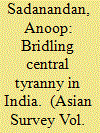

|
|
|
|
|
| Publication |
2012.
|
| Summary/Abstract |
Successive national governments in India have invoked an emergency constitutional provision to impose direct central rule in states over 100 times since 1950. However, such central government usurpation of state governance has declined since the mid- 1990s. This essay demonstrates how India's regional parties, by entering into opportunistic alliances with national parties and joining coalition central governments, have become effective barriers against central dominance. It also identifies the specific dynamics through which this effective veto power is exercised.
|
|
|
|
|
|
|
|
|
|
|
|
|
|
|
|
| 2 |
ID:
113205
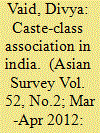

|
|
|
|
|
| Publication |
2012.
|
| Summary/Abstract |
This paper empirically analyzes the association between caste and class in India. I find a tentative congruence between castes and classes at the extremes of the caste system and a slight weakening in this association over time. Although Scheduled Castes have low upward mobility, higher castes are not entirely protected from downward mobility.
|
|
|
|
|
|
|
|
|
|
|
|
|
|
|
|
| 3 |
ID:
113199
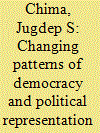

|
|
|
|
|
| Publication |
2012.
|
| Summary/Abstract |
India is the second most populous country in the world with over 1.2 billion people, and the world's "largest democracy." It is home to a bewildering number of different ethnic, religious, linguistic, caste, and cultural groups whose community boundaries are difficult to define because of both cross-cutting cleavages and overarching identities. Hindi is the country's official language of government, English has the status of "subsidiary official language," and over a dozen other languages have been officially recognized; Indian dialects number in the hundreds.
|
|
|
|
|
|
|
|
|
|
|
|
|
|
|
|
| 4 |
ID:
113202
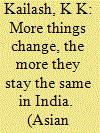

|
|
|
|
|
| Publication |
2012.
|
| Summary/Abstract |
This paper examines "no opinion" and "don't know" responses in the National Election Study 2004. Comparing responses on social and political questions, it finds that the marginalized sectors of society are more likely to be socially opinionated than to express substantive political opinions. This paradox might explain why the so-called "democratic upsurge" did not produce radical political transformation in India.
|
|
|
|
|
|
|
|
|
|
|
|
|
|
|
|
| 5 |
ID:
113204


|
|
|
|
|
| Publication |
2012.
|
| Summary/Abstract |
India has had political quotas for Scheduled Castes (SCs) since 1950. Using the 2004 National Election Study, this paper finds that neither SCs nor non-SCs feel that their vote is more/less efficacious living in SC constituencies. Yet, some evidence is found in this study that SCs are approached for their vote more often in SC constituencies. Overall, this suggests that quotas are neither associated with a strong positive reaction among SC voters nor a strong negative reaction among non-SC voters.
|
|
|
|
|
|
|
|
|
|
|
|
|
|
|
|
| 6 |
ID:
113203
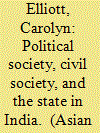

|
|
|
|
|
| Publication |
2012.
|
| Summary/Abstract |
This article is an ethnography portraying the processual and performative dimensions of the 2009 state assembly election in Andhra Pradesh. It shows how upper castes have persisted in power in a multicaste and increasingly democratic society through the distribution of welfare and patronage benefits to more marginalized segments of society. Conceptually, it argues for the importance of "political society" over "civil society," when examining state-society relations in neoliberal, democratic India.
|
|
|
|
|
|
|
|
|
|
|
|
|
|
|
|
| 7 |
ID:
113206


|
|
|
|
|
| Publication |
2012.
|
| Summary/Abstract |
This article finds, through statistical analysis of the National Election Studies (2004) data, that an increase in intergenerational education levels can positively influence an individual's political interest and political participation. Participatory trends in India are influenced by demographic factors such as caste, class, gender, income, and locality. However, this study finds that education can have a liberating effect from these various socio-economic constraints. It can provide greater access to resources and information, thus helping to increase active political participation.
|
|
|
|
|
|
|
|
|
|
|
|
|
|
|
|
| 8 |
ID:
113201


|
|
|
|
|
| Publication |
2012.
|
| Summary/Abstract |
In 2004 and 2009, the incumbent central governments in India enjoyed a high level of voter satisfaction. Why then did incumbents lose elections in 2004, while winning them in 2009? The different electoral outcomes can be explained by a combination of satisfaction with a constituent's member of Parliament and the performance of the government at the state level, as well as satisfaction with the government at the national level. This analysis rejects the conventional argument of general satisfaction with the performance of the central government as being the determinant of electoral outcomes in national elections.
|
|
|
|
|
|
|
|
|
|
|
|
|
|
|
|